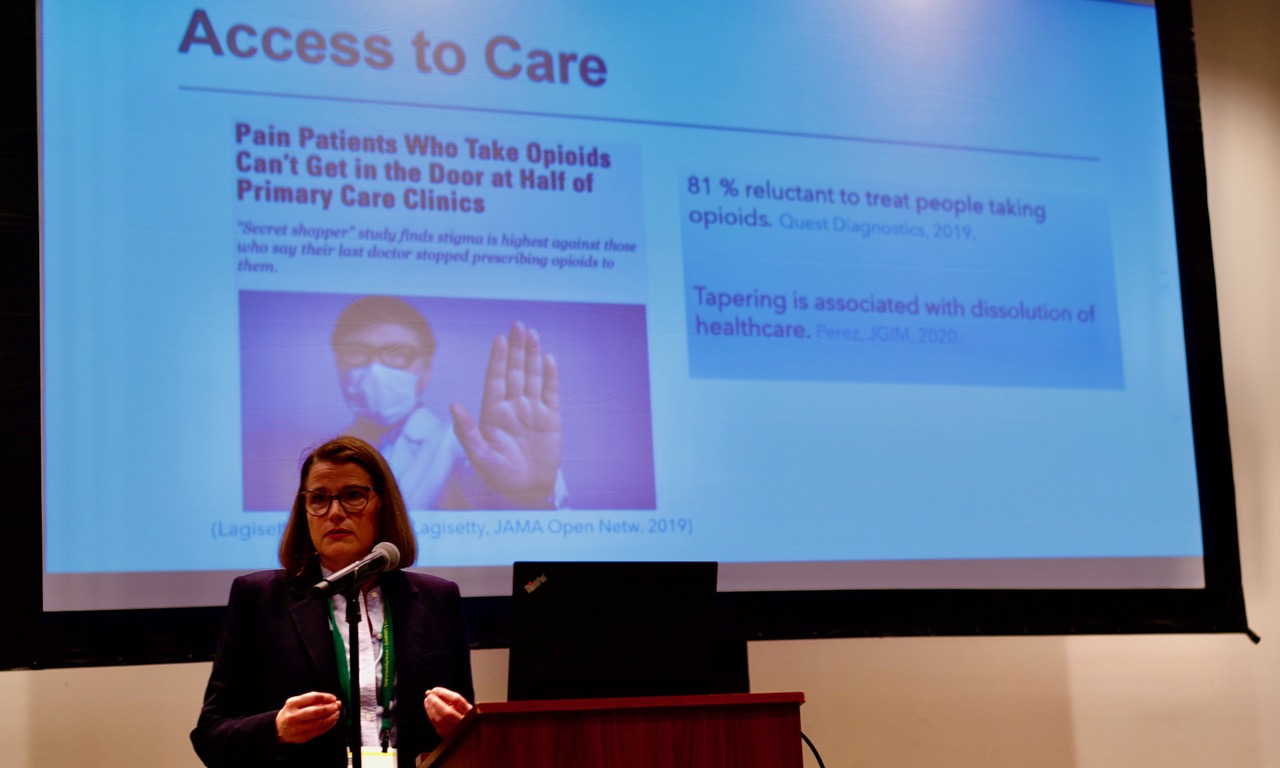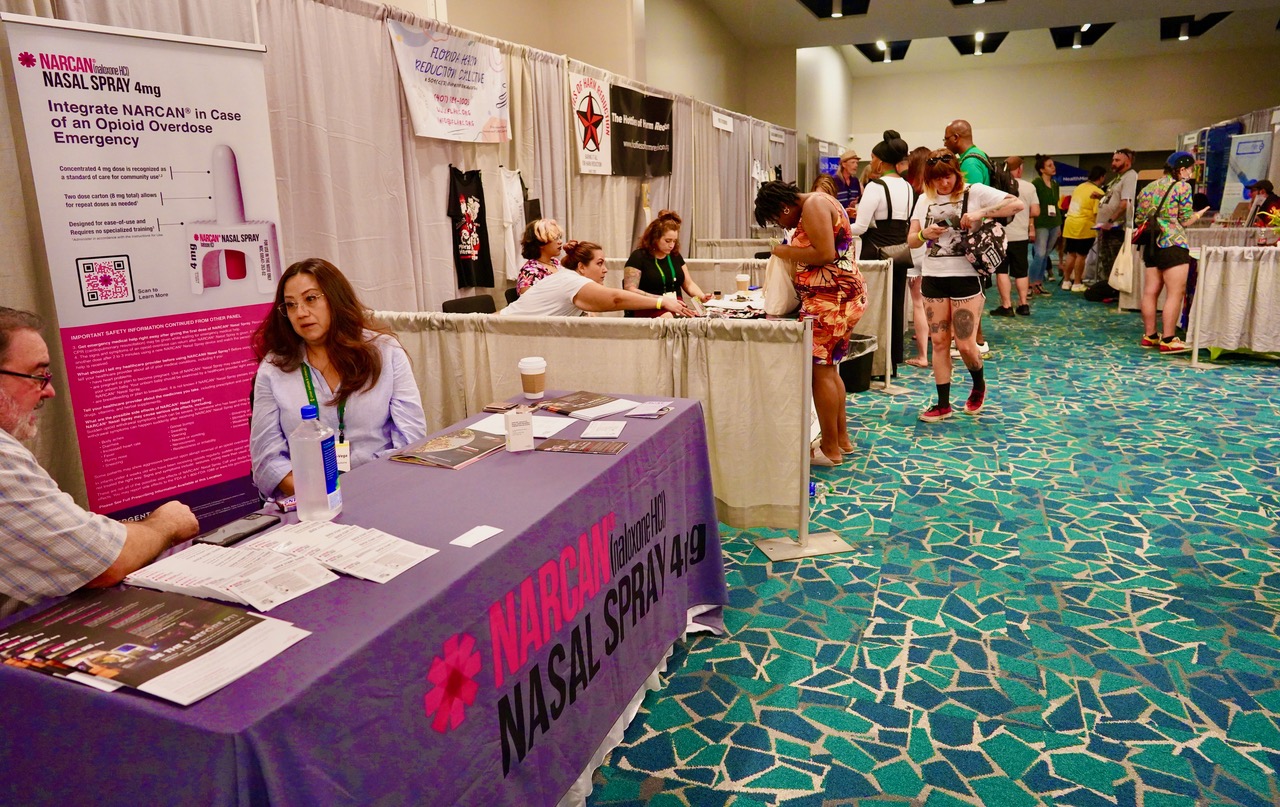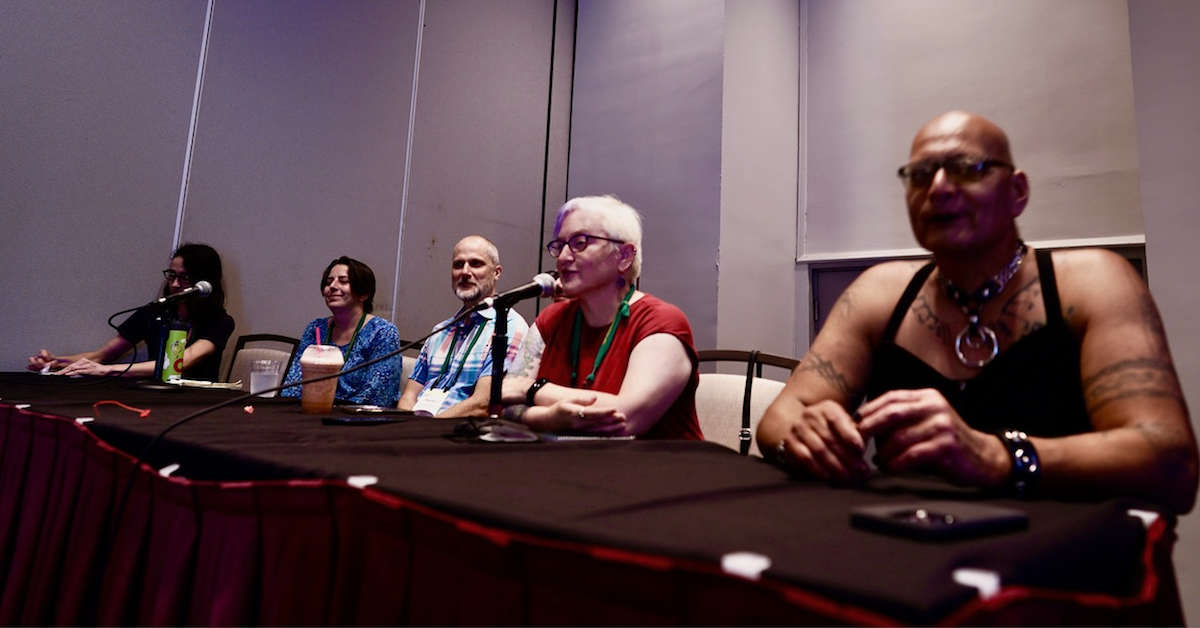Puerto Rico was the location for the National Harm Reduction Conference from October 13-16—the first to take place since 2018. The event, which is biennial in normal times, risked cancellation following the devastation of Hurricane Fiona, but ultimately went ahead with a record 2,800 people in attendance.
“After postponing the conference in 2020, we were excited when more than 2,000 harm reductionists registered,” Dr. Orisha A. Bowers, who became the executive director of the National Harm Reduction Coalition (NHRC) earlier this year, told Filter. “The 13th National Harm Reduction Conference centered the voices of people who don’t typically have access to national platforms.”
The conference featured a huge diversity of people and issues, fostering countless valuable conversations among people who use drugs and those who work in multiple ways to end the drug war. It also saw controversies and even tragedy, reflecting difficult questions and circumstances that face the movement.
The backdrop was an unrelenting overdose crisis that last year claimed the lives of over 100,000 people, and a pandemic that has so far killed over 1 million people in the US. These staggering death tolls have become normalized. For two years, the pandemic hit harm reduction programs hard; many were forced to cut back on services or close temporarily until they were able to safely reopen. Prohibition combined with government negligence has disproportionately killed members of the most vulnerable communities, particularly communities of color.
“We have lost inspiring and endlessly dedicated people in this movement,” Maurice Byrd, a therapist and director of training and business operations at the Harm Reduction Therapy Center, told Filter. “I say fuck the drug war, fuck capitalism, and fuck the white supremacist, patriarchal bullshit that we all have united to fight against.”
“The state of harm reduction in Puerto Rico is colonial. We need to … replace colonial power dynamics for new decolonizing realities.”
The opening session held at the Puerto Rico Convention Center was titled “Black, Indigenous, and People of Color Harm Reduction.” It started with an acknowledgement of the indigenous Taino people of the Caribbean. “Thank you for welcoming us to your homeland to listen, to learn, and to do the harm reduction work in this world,” said Jose Martinez of NEXT Distro. Numerous speakers expressed that the United States’ whole relationship with Puerto Rico, which it acquired as a territory in 1898 and whose citizens do not have a US vote, is racist.
“The state of harm reduction in Puerto Rico is colonial,” said Rafael Torruella, the executive director of Intercambios Puerto Rico, at the “State of Harm Reduction” session. “As a social movement, we need to not only be good at calling out oppression but replace colonial power dynamics for new decolonizing realities.”
In the United States, the Biden administration along with state and local governments continue to oppose, or refuse to fund, many proven harm reduction interventions like safe consumption sites, fentanyl test strips and safer smoking kits. Even when funding is provided, it doesn’t match the scale of need. And don’t even talk about legalizing and regulating all drugs—the only way to end the overdose crisis.
This is the world that harm reductionists, who know how to save lives but are blocked at almost every turn, must inhabit. On top of that is the trauma of losing so many people all at once, including leaders of the harm reduction community.
Among them was Mark Kinzly, a “true giant of harm reduction” who trained and inspired thousands with his work over two decades. He died in July. “Losing Mark was a blow to our collective gut and we’re still reeling from his untimely passing,” Bowers wrote in the conference program.
“It was rejuvenating to see the incredible and heroic work being done all across North America.”
So many creative and committed harm reductionists—who have continued to do the work, often isolated from one another while grieving, and providing services despite unprecedented obstacles—found it important to be together in Puerto Rico.

“The conference is always such a great reminder that DanceSafe isn’t operating in a vacuum,” Mitchel Gomez, the organization’s executive director, told Filter. “There are so many incredible people doing such great work, but it’s easy to feel siloed doing harm reduction in the music community.”
“The conference was a beautiful and much-needed convening of the harm reduction community,” Dr. Ju Nyeong Park, a researcher at Brown University, told Filter. “It was rejuvenating to see the incredible and heroic work being done all across North America.”
But tragedy struck the conference when Dr. Carmen Landau, the event’s medical director, was found dead in her hotel room. A tribute statement from Dr. Landau’s husband, shared by NHRC, said that she “died suddenly and unexpectedly” on October 14.
“She was a visionary, a teacher, and a tireless activist,” the statement continued, “who built a practice that enacted her values of antiracism, harm reduction, and reproductive justice.”

Dr. Carmen Landau. Photograph via tribute statement.
Sessions, Questions and Hope
A dizzying array of conference roundtables, workshops, and “HarmRed” talks on the program addressed dozens of issues—from antiracist addiction treatment to rural harm reduction to abortion to legalizing magic mushrooms to pain management to salud in la calle (street health). A series of meetings focused on how to lower barriers to getting life-saving medications like methadone and buprenorphine.
Another group of sessions centered on drug checking. DanceSafe has created a new fentanyl test strip that doesn’t cause false positives with methamphetamine or MDMA, or with cocaine that contains levamisole or lidocaine. “Strangers With Candy in a Van: The Long Game of Street-Based Mobile Harm Reduction Therapy,” was the title of one meeting. Another, regarding the campaign for safe consumption sites, was: “WTF is going on in San Francisco?”

Kate Nicholson, JD, of National Pain Advocacy Center
At “How Housing First and Harm Reduction Led to Long-Term Stability,” Nicole Callaghan and Charlene Wilson of Alpha House Society in Calgary, Canada explained how permanent, supportive housing programs work for the most marginalized people. The housing first philosophy allows people to use drugs in their homes, with no abstinence requirement. Overdose prevention at Alpha House includes asking tenants who use to keep their door open, or have staff call them after consuming drugs.
“We have to think outside the box and get creative with how to keep people alive,” Wilson said. She and Callaghan noted that not all tenants reduce their drug use once they are stably housed, and that’s fine because housing is the point. Alpha House residents are mainly members of the Lakota tribe. Professional staff and peer workers have close ties with community elders to provide culturally appropriate services. The speakers acknowledged that much of the success of this work relates to Canada’s universal health care system, where drug treatment and mental health services are free.
On the panel “Tobacco Harm Reduction and the Right to Health,” in which I participated, Kevin Garcia discussed the need to integrate tobacco harm reduction (THR) into services for people who use state-banned drugs, who smoke at very high rates. Each year, over 480,000 people in the US die of smoking-related causes. Garcia, who has vaped nicotine for years and makes his own e-liquid, debunked the claim that vaping has comparable dangers to cigarettes.
“I feel like THR has to be taken more seriously amongst the harm reduction community,” Presto, an attendee who uses banned drugs and vapes occasionally, told Filter. “We’re very much focused on the situations where an overdose happens, where it’s rapid onset, and we’re trying to prevent those things from happening but we also have to focus on long-term HR.”

Helen Redmond, Dr. Patt Denning and Kevin Garcia at “Tobacco Harm Reduction and the Right to Health.” Photograph by Marilena Marchetti
Despite the many positives of the conference, some attendees, and others online, expressed a number of concerns and complaints. There were controversies over some panels and speakers, and observations that certain areas of harm reduction—stimulants, for example—were underrepresented in the program.
Dinah Ortiz, who identifies as a drug user and human rights activist and has attended many past conferences, referred to what she termed “the good, the bad, the ugly” in Puerto Rico. “The camaraderie and fellowship were a plus,” she told Filter. “But I can always count it as a space where I felt comfortable in my skin identifying as a drug user … this was not that.” What she described as a relative lack of drug-user centered panels “left me confused,” she said.
There were concerns that COVID precautions were not emphasized in a space with many vulnerable participants.
There were also access issues at the split venues for disabled attendees, and complaints that the high cost of attending the conference, with no online option, was a major barrier.
“We awarded over 500 scholarships and 50 childcare stipends,” Bowers told Filter in response. “On accessibility, the goal for attendance was 1,500 registrants. When that number doubled, we expanded to an overflow hotel and moved sessions to the PR convention center … We asked people to indicate their needs for disability accommodations and language services. I truly believe that we made every effort to assist with removing as many barriers as possible to help people attend the conference while upholding our commitment to the harm reduction community in PR.”
There were concerns, too, that COVID precautions were not emphasized in a space with many vulnerable participants. After the conference, dozens of attendees reportedly tested positive for the coronavirus.
“It would have been a safer space if NHRC had required masking in the workshops,” Dr. Patt Denning, another veteran of many conferences, told Filter.
“The conference app didn’t have a section on COVID-19, which is outrageous given that the conference was held during COVID,” said another attendee, requesting anonymity. “There was no information about safety or on-site testing in the Environment Statement section of the app, which had subsections on medical concerns and collective safety … Masks were not available or mentioned at registration.” This matched my own experiences.
“The conference was a moment to celebrate the work of peers and the opening of the USA’s first overdose prevention centers.”
“We followed the approved and recommended protocol for in-person convening,” Dr. Bowers responded. “We requested attendees provide proof of vaccination or proof of a negative test result within 48 hours of registration. Additionally, although masking was not required by the venue, people had the option to mask, we provided masks, COVID testing and resources on-site.”

Booths at the conference
It should be emphasized again how many workshops and plenaries in Puerto Rico highlighted vital work, platformed people with lived experience and gave beleaguered harm reductionists a long-awaited opportunity to gather.
The event was also able to showcase some critical recent harm reduction victories.
“The conference was a moment to celebrate the work of peers and the opening of the USA’s first overdose prevention centers—they are supported in 15 countries around the world,” Naomi Burke-Shyne, the executive director of Harm Reduction International, told Filter. In November 2021, OnPoint NYC opened the country’s first two sanctioned safe consumption sites, as they are also known, in East Harlem and Washington Heights. Staff and peers have since averted at least 553 overdoses.
Like other groundbreaking initiatives showcased in Puerto Rico, finally opening these centers offered inspiration and hope to the thousands of harm reductionists who work every day, against all odds, to save lives.
Photographs by Helen Redmond unless stated. Top photograph shows the panel “WTF Is Going On in San Francisco?” and includes, from left to right: Lee of San Fransico AIDS Foundation; Daniela Wotke of the HIV Education and Prevention Project of Alameda County (HEPPAC); Dr. Alex Kral of RTI International; Laura Thomas of San Fransico AIDS Foundation; and Felani of Glide HRx.





Show Comments